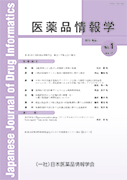Volume 17, Issue 1
May
Displaying 1-8 of 8 articles from this issue
- |<
- <
- 1
- >
- >|
Review
-
2015 Volume 17 Issue 1 Pages 1-10
Published: 2015
Released on J-STAGE: June 28, 2015
Download PDF (602K)
Original article
-
2015 Volume 17 Issue 1 Pages 11-14
Published: 2015
Released on J-STAGE: June 28, 2015
Download PDF (756K) -
2015 Volume 17 Issue 1 Pages 15-20
Published: 2015
Released on J-STAGE: June 28, 2015
Download PDF (457K) -
Examining the Effect of Pharmacists’ Visits to Homebound Patients on the Elimination of Unused Drugs2015 Volume 17 Issue 1 Pages 21-33
Published: 2015
Released on J-STAGE: June 28, 2015
Download PDF (694K)
Short communication
-
2015 Volume 17 Issue 1 Pages 34-38
Published: 2015
Released on J-STAGE: June 28, 2015
Download PDF (1637K)
Note
-
2015 Volume 17 Issue 1 Pages 39-44
Published: 2015
Released on J-STAGE: June 28, 2015
Download PDF (573K) -
2015 Volume 17 Issue 1 Pages 45-52
Published: May 30, 2015
Released on J-STAGE: June 28, 2015
Download PDF (1399K)
Series
-
2015 Volume 17 Issue 1 Pages N1-N4
Published: May 30, 2015
Released on J-STAGE: June 28, 2015
Download PDF (713K)
- |<
- <
- 1
- >
- >|
